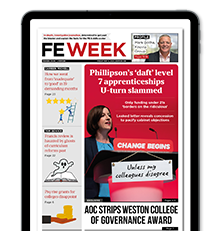The skills minister has set a new “ambitious” target for an overall 67 per cent achievement rate on apprenticeship standards by 2025 – a 15 percentage point increase on the current rate.
He has also announced a new exit feedback tool for drop-outs to better understand why half of apprentices withdraw.
Alex Burghart told today’s Association of Employment and Learning Providers national conference that government will provide a package of support to address the issues, including workforce development and “continued targeted support for employers”.
He has outlined further details in a letter to the sector.
The achievement rate on standards is a big issue for ministers and was named as one of the top concerns for Amanda Spielman at Ofsted and Jennifer Coupland at the Institute for Apprenticeships and Technical Education during their speeches at AELP’s conference earlier today.
New-style apprenticeship standards only achieved 51.8 per cent achievement rate in 2020/21, a slight improvement on the achievement rate of 45.2 per cent in 2019/20.
Meanwhile, old-style frameworks, which are being phased out, hit a 68.1 per cent achievement rate in 2019/20 and 68.9 per cent achievement rate in 2020/21.
Only one of the 11 subject sector areas – science and mathematics – had an overall achievement rate of above 67 per cent on standards in 2020/21.
Announcing the 67 per cent target, Burghart said: “I know this is not an easy task, I know it is made harder by the impact of the pandemic and the associated challenges that you, employers and apprentices themselves have faced.
“It will require a combined effort from everyone, and we want to work with you on it.
“I am confident that by prioritising quality, we can make progress towards this point in the coming years.”
But AELP chief executive Jane Hickie fears the target will be unachievable.
She told FE Week: “While this new target is certainly very ambitious, there is a danger that we are trying to compare frameworks to standards when they are not like for like.
“AELP feels the target will unfortunately be unachievable until the DfE iron out unhelpful nuances in the current qualification achievement rate methodology – updating and reflecting the new climate that we’re all working in. Without revisions, there is a real risk of undermined confidence in apprenticeships.”
Government data shows that only 53 per cent of apprentices on standards stayed on their programme until their end-point assessment in 2020/21 – meaning that 47 per cent dropped out.
The drop-out rate for frameworks was 17 percentage points lower than standards in 2020/21.
By comparison, latest Department for Education data shows the drop-out rate for A-levels in 2019 was less than one in ten (8.7 per cent).
Burghart said the DfE is looking at “kickstarting” the feedback tool in the department, and it is the DfE’s intention to collate the data rather than providers or employers. The DfE is aiming to have the tool up and running this autumn.
A DfE apprentice survey published last month found that personal or domestic factors such as a better job offer, mental health issues or caring responsibilities were among the key reasons for apprentices dropping out in 2019/20.
And when it comes to apprenticeship-related factors for withdrawals, the most common reasons were that apprentices felt they did not have enough time for training, poor quality training and badly run programmes.

















AELP are right. Frameworks v standards is not comparing like with like for many reasons and a sector supporting magazine should probably be seeking to understand the reasons why.
Comparing to A levels is also meaningless, but we have yet to see A levels compared to other programmes like; Kickstart, Traineeships, AEB classroom based, DWP work programmes, prison education etc etc.
The sprinkling of unnecessary words such ‘only’, ‘slight’ says a lot. I’m staring to fear that FE Week is only one step away from featuring scantily clad models to drive up advertising revenue.
There are several big challenges around Standard achievement, but the three big areas that need to be tackled to support Training providers to achieve this target are:
1. Review and incremental increase of all funding band rates, particularly at anything below £5k, most bands have remained static since they were introduced in 2017 apart from those that have been reduced as part of IFATE reviews and lower funded standards are becoming unviable to deliver
2. Review of Functional Skills funding rates, providers can improve on delivery and performance but it has to be funded appropriately aligning the rates for FS included in Apprenticeships to standalone would help
3. Review of EPA practice and timelines, our average wait for Students to get from Gateway to EPA is 16 weeks, many students drop our whilst waiting – particularly in sectors like Care where they already have the mandatory Qual.
The Government also needs to understand the difference between Retention and Quality, many students leave programme because they change employer and cannot be followed, many leave because they cannot pass functional skills and others leave because employers will not fund resits.
A quality measure that is never taken into account is EPA pass rates that sit well into the late 90%’s